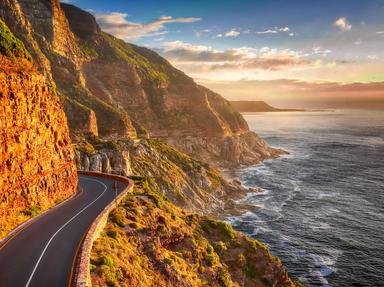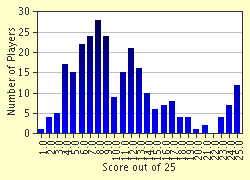Quiz Answer Key and Fun Facts
1. A is for Agriculture and Arable land - Only 11 percent of South Africa's land is arable, and roughly 66 percent is only suitable for livestock grazing. Is South Africa a net importer or exporter of agricultural products?
2. B is for Bungy jumping and Bridges - where in South Africa will you find the world's highest commercial bungy jump?
3. C is for Climate - What part of the country has a humid sub-tropical climate, and higher rainfall than the rest of the country?
4. D is for Diamonds and De Beers - De Beers produces approximately 40% of the world's supply of rough diamonds. It owns a number of mines in South Africa, and has its corporate headquarters in Johannesburg. Where in South Africa are the majority of diamonds mined? (Beginning of the 21st century).
5. E is for Escarpment - This is a series of mountain ranges separating the high interior plateau from the low lying coastal areas. What rock type is the Drakensberg predominantly made up of?
6. F is for Floral Kingdoms - The Cape Floral Kingdom is unique to the Western Cape, and contains over 8000 species of plant. Which species make up the majority percentage of the kingdom?
7. G is for Gauteng and Gold - The name Gauteng comes from the Sesothu word for "Place of Gold", and the province was built on the strength of its gold reserves. What approximate percentage of the entire world's gold ore reserves are found deep below Gauteng?
8. H is for Highveld - a high plateau area in the interior of the country, occupying the eastern part of the Free State, southern Mpumalanga, Gauteng and the eastern parts of the North-West Province. At what altitude is the Highveld situated?
9. I is for International Boundaries - which of the following countries does South Africa NOT share an international border with?
10. J is for Johannesburg / Jozi / Jo'burg - the largest, richest, most powerful, most densely populated city in South Africa. It is known as the Gateway to Africa, and tends to have the highest, biggest, strongest, of everything. What high structure, completed in 1971, has been the tallest in Johannesburg for over 30 years?
11. K is for Karoo - The Karoo is a semi-desert area and is one of the world's richest fossil deposits grounds. On 17 November 1998, the first complete fossil remains of a prehistoric predator were found. What is the fossil?
12. L is for Lakes and Lagoons - What is the largest natural fresh water lake in South Africa?
13. M is for Mining and Minerals - South Africa is rich in mineral resources, and is the world largest producer of a number of minerals. What mineral does South Africa NOT mine?
14. N is for National Symbol - which of the following is NOT a national symbol of South Africa?
15. O is for Ocean Currents - What is the name of the cold ocean current that sweeps up from the Antarctic along the Atlantic coast of South Africa?
16. P is for People - What people were the original inhabitants of South Africa?
17. Q is for Quakes - the natural disaster earthquake type. What is the strongest magnitude of earthquake to occur in South Africa, between the years 1900 and 2000, based on the Richter Scale?
18. R is for Rivers - South Africa has no commercially navigable rivers, and is a very arid country, which relies on heavily on dams to provide water. Listed below are major tributaries and their corresponding rivers. Which one is NOT correct?
19. S is for Staple Crops - What is the staple crop of South Africa?
20. T is for Tugela Falls - This waterfall is situated on the Tugela River in the Drakensburg. With a total drop of 947m, it is one of the highest waterfalls in the world. What position does it hold?
21. U is for Underwater - There are very few places in the world where more than one species of kelp grow together. South Africa has an area where three species of giant kelp grow together. Where is this kelp forest?
22. V is for Valley of 1000 Hills - The Valley of 1000 Hills has 15 conservancies, the highest concentration in the province of KwaZulu-Natal. Which of the following reserves is one of the 15?
23. W is for Witwatersrand - Which of the following lists of towns defines the range of the Witwatersrand from one end to the other?
24. X is for Xhosa - Which province is the traditional home of the Xhosa people?
25. Z is for Zebras and other wildlife - South Africa has a few Transfrontier national parks, (Parks shared with other countries, and crossing international borders). Which is the largest?
Source: Author
51percent
This quiz was reviewed by FunTrivia editor
minch before going online.
Any errors found in FunTrivia content are routinely corrected through our feedback system.

